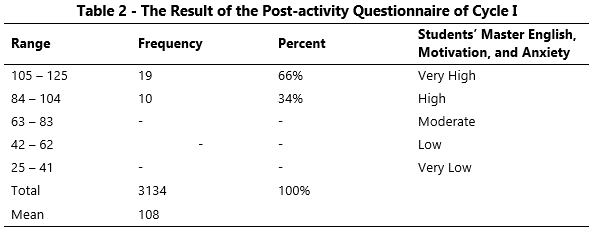Enhancing Speaking Skills of Senior High School Students Using Sims Freeplay
Main Article Content
Abstract
This study aimed to improve students’ speaking skills using Sims Freeplay through action research based on the Kemmis and McTaggart model, which includes five steps: reconnaissance, planning, action, observation, and reflection. The participants were 29 students from class XI-1 of a senior high school in Yogyakarta, consisting of 12 females and 17 males. Qualitative data were collected through observations and interviews, while quantitative data were gathered using pre-tests and post-tests. Data analysis involved five steps: assembling, coding, comparing, interpreting, and reporting the outcomes. The validity of the data was measured using democratic, outcomes, process, catalytic, and dialogic validity, while reliability was ensured through time triangulation. The results showed improvements in students’ speaking skills, with mean scores increasing from the pre-test (12.28) to post-test cycle I (13.28) and post-test cycle II (14.31), reflecting an 8% increase in cycle I and 9% in cycle II. Reflection from cycle I revealed improvements in vocabulary, fluency, pronunciation, grammar, and sentence organization. Anxiety levels decreased from a mean score of 14.87 to 12.66, while motivation increased from 17.21 to 20.20. Sims Freeplay proved to be an effective and engaging tool for learning English, significantly enhancing students’ speaking skills and creating a positive learning experience.
Article Details

This work is licensed under a Creative Commons Attribution 4.0 International License.
References
Afshar, H. S., & Asakereh, A. . (2016). Speaking skills problems encountered by Iranian EFL freshmen and seniors from their own and their English instructors’ perspectives. Electronic journal of Foreign language teaching, 13(1), 112-130. Retrieved from http://e-flt.nus.edu.
Alizadeh, M. (2016). The Impact of Motivation of English Language Learning. Islamic Azad Islamic Azad.
Al-Roud, A. A. (2016). Problems of English Speaking Skill that University Students Encounter from Their Perspectives. British Journal of Education,Society & Behavioural Science, 18(3): 1-9 : DOI: 10.9734/BJESBS/2016/28404. .
Alyan, A.A. (2013). Oral Communication Problems Encountering English Major Students: Perspectives of Learners and Teachers in Palestinian EFL University Context. Arab World English Journal, (4) 2, 226-238.
Bahadorvar, M., & Omidvar, R. . (2014). Technology in Teaching Speaking Skill. Research Gate. Retrieved September 16, 2022, from https://www.researchgate.net/publication/315790125_TECHNOLOGY_IN_TEACHING_SPEAKING_SKILL.
Bashori, M. v. (2020). Web-based language learning and speaking anxiety. Computer Assisted Language Learning, DOI: 10.1080/09588221.2020.1770293.
Bekai, W., & Harkouss, S. (2018). The role of motivation in teaching speaking in esp: a case study of a Lebanese Private University. The journal of teaching English for specific and academic purposes, 6(1), 141150. Https://doi.org/10.22190/JTESAP1801141B.
Brown, H.D. (1994). Teaching by principles: an interactive approach to language pedagogy. Englewood Cliffs.
Carlton, M. P. (2003). Motivation in language learning. Cambridge University Press.
Darling-Hammond, L., Flook, L., Cook-Harvey, C., Barron, B. and Osher, D. (2020). Implications for educational practice of the science of learning and development. Applied Developmental Science, Vol. 24 No. 2, pp. 97-140, doi: 10.1080/10888691.2018.1537791.
Gallego, A. M. (2022). Measuring Public Speaking Anxiety : Self-report, behavioral, and physiological. Behavior Modification, 46(4), 782-798. https://doi.org/10.1177/0145445521994308.
Harris, D. P. (1974). Testing English as a second language. McGraw-Hill.
Hasibuan, S. (2019). Devpelopment of Child Worksheets Based on the Story as Subtheme “My Body” to Improve Students' Speaking Abilities at Al-Ikhlas Early Childhood Education and Development (ECED) Medan Amplas. Budapest International Research in Linguistics and Education Sciences (BirLE), 539-546.
Hayikaleng, N., Nair, S. M., & Krishnasamy, H. N. (2016). The Students Motivation on English Reading Comprehension. English Reading Comprehension.
Horton, W. S. . (2017). Theories and Approaches to the Study of Conversation and Interactive Discourse. ResearchGate.
Jaya, H. P., Petrus, I., & Pitaloka, N. L. (2022). Speaking performance and problems faced by English major students at a university in South Sumatera. Indonesian EFL Journal, 8(1), 105-112 : https://doi.org/10.25134/ieflj.v8i1.5603.
Kemmis, S., & McTaggart, R. . (2008). Participatory Action Research: communicative action and the public sphere. In N. Denzin, & Y. Lincoln, Strategies of Qualitative Inquiry. London : SAGE.
Lai, R. E. (2011). Motivation: A Literature Review. Pearson.
Melouah, A. (2013). Foreign language anxiety in EFL speaking classrooms: A case study of first-year LMD students of English at Saad Dahlab University of Blida, Algeria. Arab World English Journal, 4(1), 64-76.
Mettetal, G. (2015). Improving Teaching Through Classroom Action Research . ResearchGate.
Pangaro, P. . (2017). Questions for conversation theory for conversation theory in one hour . Emerald Insight .
Putri, A. (2016). Low Motivation in Learning Speaking. ResearchGate.
Rajitha, K. et al. (2020). A Study of Factors Affecting and Causing Speaking Anxiety. ScienceDirect.
S. Kemmis et al . (2014). The Action Research Planner. Singapore, Heidelberg, New York, Dordrecht, London: Springer.
S.Q. Cabell et al. (2015). Teacher–child conversations in preschool classrooms: Contributions to children’s vocabulary development. ScienceDirect .
Shaurya Bhatnagar et al. . (2023). Detection and classification of anxiety in university students through the application of machine learning. ScienceDirect.
Shen, M. &. (2019). EFL learners’ English EFL learners’ English . Education and Linguistics Research, 5(2), 88-102.
Spitzley, L. A., Wang, X., Chen, X., Pentland, S. J., Nunamaker, J. F., Burgoon, J. K., & Dunbar, N. E. (2022). Non-Invasive Measurement of Trust in Group Interactions. IEEE Transactions on Affective Computing, 1–1. https://doi.org/10.1109/TAFFC.2022.3160132.
Syakur. (2007). The components of speaking skill. Retrieved from https://es.scribd.com/doc/106593833/9/The-Components-of-Speaking-Skill.
Yuliana, A. S., and A. Soegito. (2013). The application of audiolingual method to improve students speaking ability. Jurnal Pendidikan Bahasa Inggris STKIP PGRI Sidoarjo, 1(1):88-93.
Zhang, Y. (2009). Reading to Speak: Integrating Oral Communication Skills. English Teaching Forum, 47, 32-34. http://files.eric.ed.gov/fulltext/EJ923446.pdf.
Zyoud, M.M. (2016). Theoritical Perspective on How to Develop Speaking Skill among University Students. Research Gate.
